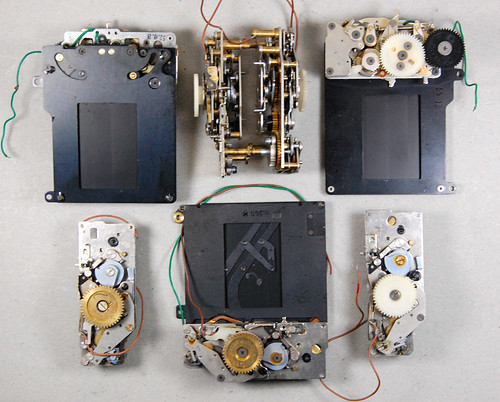Focal plane shutter
A focal plane shutter is so named because it sits directly in front of the focal plane (i.e., the film or image sensor) of the camera. This is an advantage for interchangeable-lens cameras, because lenses do not need to have shutters built into them, and they can be removed and replaced while the shutter blocks light from the film.
The most common type of focal plane shutter is the two-curtain type first used by Leica, and subsequently copied by almost all other camera manufacturers. It uses two fabric curtains travelling in the same direction across the focal plane. The first curtain opens across the focal plane, and after the appropriate delay, the second curtain closes behind it. In most focal-plane shutters, the curtains travel at the same speed regardless of the speed setting: the shutter speed, the amount of time the film is exposed, is determined by the delay between the time the first curtain opens and the time the second curtain closes. Cocking the shutter moves the curtains back to their starting position. Because of the relative simplicity of this mechanism, it's easy to build shutters which can work accurately at very high shutter speeds, up to 1/2000 second.
Modern focal plane shutters may operate either horizontally, as in the original Leica design, or vertically, as in the original Contax design. They may be made of fabric or of light metal sheets. (See FP sync.)
Pros
- The biggest advantage of a focal plane shutter is economy: for the best optical characteristics, leaf shutters must be located inside the lens, so lenses for leaf shutter systems are more expensive. (Behind-lens leaf shutters exist, but are considered sub-optimum.)
- Focal plane shutters can be designed with higher speeds than leaf shutters. Leaf-shutters going up to at most 1/400 were common at one time, but focal plane shutters have been able to achieve 1/1000 using the moving-slit principle from almost the time they were invented. Plastic or metal-blind focal plane shutters often achieve 1/2000 and some exist on late SLR's that achieve 1/3000 or better.
- In film cameras with interchangeable lenses, the shutter protects the film from light and dust when changing lenses.
Cons
- X-sync can only be used up to a maximum shutter speed on focal plane cameras, unlike leaf shutters which can sync at any shutter speed. This is because a focal plane shutter is only fully open up to a certain speed, usually about 1/60th of a second. At higher speeds, an increasingly narrow slit moves across the film plane, so a flash exposure would only expose a portion of the frame. Leaf shutters, on the other hand, open fully even at their highest speeds, allowing flash synchronization at all speeds.
- Focal plane shutters are noisier than leaf shutters.
- Moving subjects can be distorted by the travelling slit of a focal plane shutter.
- Focal plane shutters are often more susceptible to damage, as they are usually cloth and are highly exposed whenever the camera is open.

|
| Copal Vertical Focal Plane Shutters image by Hans Kerensky (Image rights) |
Focal plane shutter evolution
To partially address the low maximum shutter speeds usable with flash, later focal plane shutters - starting with the Copal Square shutter from the 1960s - now employ lightweight metal or polymer blades, moving vertically, replacing the original cloth blinds. These permit sync speeds of up to 1/250 sec.[1]